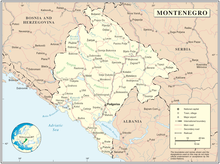

The following outline is provided as an overview of and topical guide to Montenegro:
Montenegro – sovereign country located on the Balkan Peninsula in Southern Europe.[1] It has a coast on the Adriatic Sea to the south and borders Croatia to the west, Bosnia and Herzegovina to the northwest, Serbia and Kosovo to the northeast, Albania to the southeast. Its capital and largest city is Podgorica, while Cetinje is designated as the Prijestonica (meaning the old royal capital or former seat of the throne).
The thousand-year history of the Montenegrin state begins in the 9th century with the emergence of Duklja, a vassal state of Byzantium. In those formative years, Duklja was ruled by the Vojislavljevic dynasty. In 1042, at the end of his 25-year rule, King Vojislav won a decisive battle near Bar against Byzantium, and Duklja became independent. Duklja's power and prosperity reached their zenith under King Vojislav's son, King Mihailo (1046–81), and his son King Bodin (1081–1101).[2] From the 11th century, it started to be referred to as Zeta. It ended with its incorporation into Serbia in the late 1180s. Beginning with the Crnojević dynasty (late 15th century), Upper Zeta was more often referred to as Crna Gora or by the Venetian term monte negro. A sovereign principality[3] since the Late Middle Ages, Montenegro saw its independence from the Ottoman Empire formally recognized in 1878. From 1918, it was a part of various incarnations of Yugoslavia. On the basis of a referendum held on 21 May 2006, Montenegro declared independence on 3 June. On 28 June 2006, it became the 192nd member state of the United Nations;[4] on 11 May 2007 the 47th member state of the Council of Europe;[5] and on 5 June 2017, the 29th member of NATO. On 15 December 2008, Montenegro presented its official application to the European Union, with the hopes of gaining EU candidate status by 2009.[6]
- ^ "Montenegro". The World Factbook. United States Central Intelligence Agency. July 14, 2009. Retrieved July 23, 2009.
- ^ "Duklja (Doclea), the first Montenegrin state". Archived from the original on 1997-01-16.
- ^ "Zeta (Duklja) under the second Montenegrin dynasty, the Balsic (1356-1427)". www.montenegro.org. Archived from the original on 16 January 1997. Retrieved 13 January 2022.
- ^ List of members to the United Nations by joining date
- ^ Directorate of Communication - The Republic of Montenegro becomes 47th Council of Europe member state
- ^ Montenegro files EU membership application

